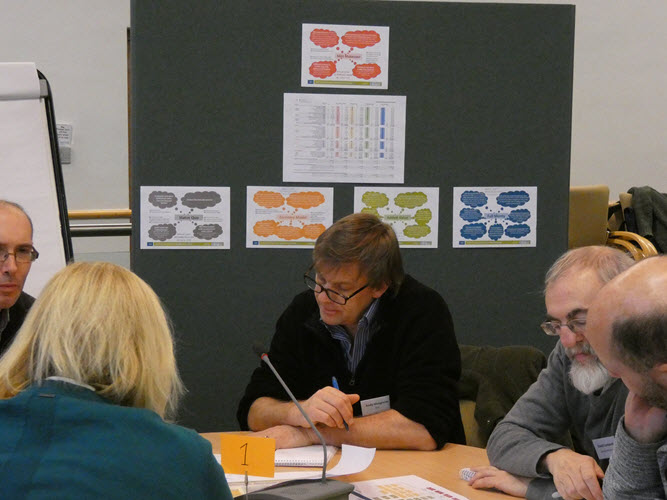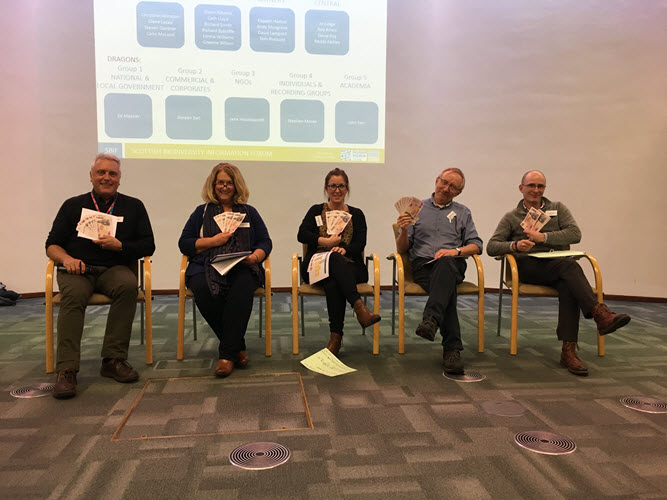The fourth (and final) in our series of workshops aimed at identifying and evaluating different scenarios for the re-design of the biological recording infrastructure in Scotland was held on the 4th and 5th December 2017, at Scottish Natural Heritage’s Battleby Conference Centre near Perth.
Following a similar format to previous workshops at which we created and proposed a new Data Flow model (Workshop 1), then created an emerging service catalogue and a proposed Service Provision model (workshop 2), and then developed a proposed Governance model (Workshop 3), in this workshop twenty-six attendees were invited to identify a preferred investment option for the infrastructure and to consider and / or design the funding mechanisms that could sustainably support this option in perpetuity.

Following an introduction to the Review and an update on the key message from the previous stages and workshops, the attendees were divided into groups and invited to examine the possible investment options. The ‘Status Quo’ option was ruled out from the start so four other options, named the ‘Mini Makeover’; ‘Economy’; ‘Added-Value’ and ‘Full Monty’ (and representing the lowest to highest level of funding respectively), were looked at.
The attendees then re-grouped by sector (national & local government; commercial; NGOs; individuals & recording groups; and academia) and discussed five questions about funding mechanisms, including what motivates a funder, which funding streams are most suitable, how would a funding stream operate, what is the expected return on investment and what would success look like.
Dragon’s Den
Day One was rounded off with a ‘Dragon’s Den’ style of session designed to challenge our thinking on suitability and attractiveness of investment. Five attendees each played the role of a Dragon, one for each sector, and the rest of the workshop divided into two groups in order to make two pitches for investment. The Dragons questioned the groups intently on points of detail in order to decide if they would invest some of the £12 million they each had to ‘spend’. None of the Dragons felt able to fund us completely – they would form a partnership to fund the infrastructure on condition the two groups joined forces and collaborated – an excellent reminder that collaboration and partnership will be key to our success!

Day Two
Day Two commenced with a session on levels of investment and, armed with scissors, tape and glue, the four groups were invited to mix and match different parts of the four options for funding to reach a preferred model. After a presentation from each group, individuals voted for their preferred model – the winner was one closely matching the original ‘Full Monty’. The groups then went on to consider the business changes required to take forward this model and the workshop closed just before lunch with some reflection on the two days.
Messages
Some important messages from this workshop were:
- To attract significant funding we need to work together at the regional, national and central levels (reaching out to the whole UK) to remove competition for funds and share costs across sectors while joining up data to maximise benefits and hence return on investment.
- We should make a bold request for funding; the status quo is not an option, we must ask for the full amount of investment that is needed to ensure that a properly functioning governance structure can be supported, so that the level of investment sought is significant enough to make it sufficiently beneficial and motivational for the change involved to be worthwhile.
- We should capitalise on existing shared services (e.g. admin and Finance) to potentially reduce some areas of cost.
- Proposals to increase regional and super partner resource are very welcome and timely.
- We will ensure that funding options incorporate a greater level of resource to facilitate overheads such as public liability insurance, advocacy and income generation resources, and for QA/verification, while clarifying what is existing spend/income and what is new.
- We recommend the adoption of a subscription model for those who make academic or commercial use of the data and for those who have a requirement to demonstrate fulfilment of biodiversity duty (e.g. local authorities and farm businesses).
Workshop outputs
The proposed Funding model, transcript of the workshop discussions and full set of key messages, are included in the workshop outputs document. These outputs and the outputs from all the other workshops can be downloaded from the SBIF Review pages of the NBN website.
Thanks to everyone who attended and participated in the workshop. Thanks also to Liz Edwards, and Ellen Wilson for planning, creating and facilitating the workshop, and to Rachel Stroud for her input to the planning stage, and thanks to the Scottish Wildlife Trust for funding the catering and to SNH for hosting the event.
At the end of Day 1 Ed Mackey (SNH) made some closing remarks highlighting the importance of aligning the work of the Review with Scotland’s strategic aims, as outlined in a recent blog post by SNH (He also proposed a vote of thanks to the workshop organisers and attendees, which was well received.
Next steps
The next stage for the Review is publication of our recommendations, hopefully in the 1st Quarter of 2018. The Funding model, together with the proposed Governance, Service Provision and Data Flow models will be used as the framework on which the recommendations will be based. Updates on the Review will continue to be published in Network News, and please do share the updates amongst your contacts.
For further information please contact Christine Johnston, NBN Scottish Liaison Officer.
